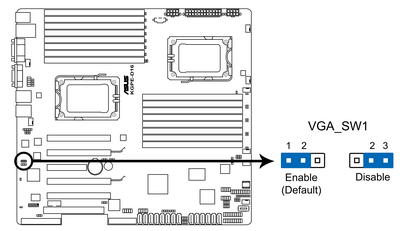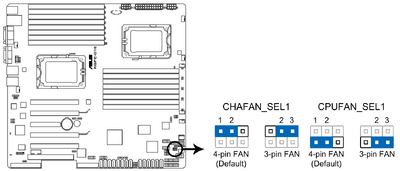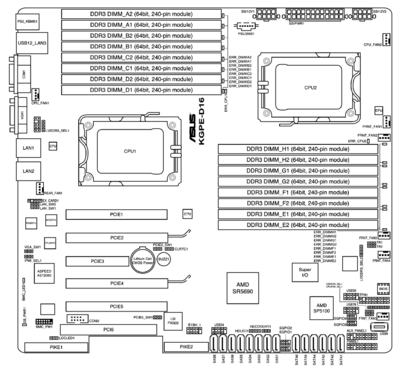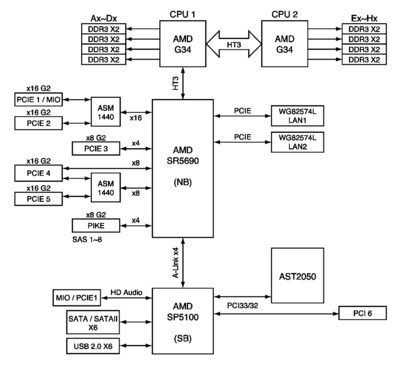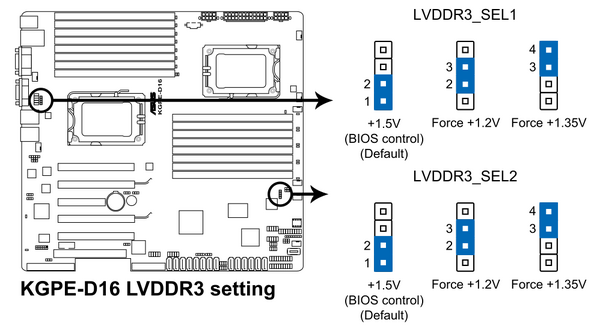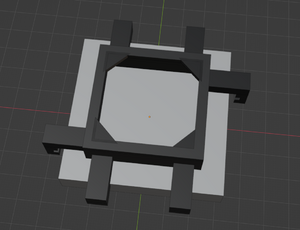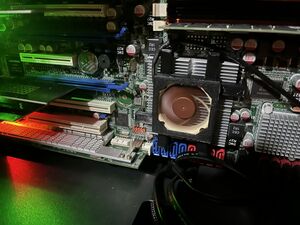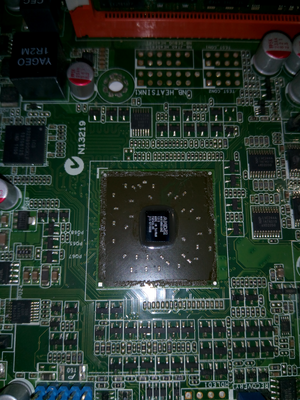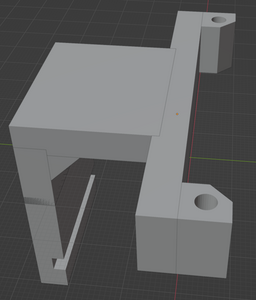KGPE-D16
| KGPE-D16 | |
|---|---|
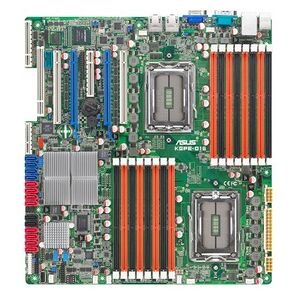 | |
| Overview | |
| Introduced | 2010 |
| Manufacturer | ASUS |
| Specifications | |
| Socket | 2x G34 |
| Northbridge | AMD SR5690 |
| Southbridge | AMD SP5100 |
| Super I/O | Winbond W83667HG-A |
| BMC | ASPEED AST2050 |
| BMC Flash Location | Removable Module |
| Memory | 16 slots (8 channels) DDR3-1600 ECC UDIMM/RDIMM/LRDIMM, up to 512GB on coreboot |
| BIOS Flash | 2 MiB socketed DIP-8 (W25Q16V) |
| Form Factor | SSI EEB |
| Power Inputs | 2x 8-pin EPS |
| Expansion Slots |
|
| Onboard Peripherals | |
| Graphics Adapter | AST2050 Integrated VGA |
| Network Interface | 2x Intel 82574L Gigabit |
| Storage Controller | SP5100's SATA2 (3.0 Gbps), no SAS unless PIKE2008 installed |
| USB Controller | SP5100's onboard USB 2.0 |
| Serial Interface | One SIO-provided RS232, one virtual BMC console port |
| Audio Interface | None (ASUS recommended a PCI sound card) |
The ASUS KGPE-D16, commonly referred to as the D16, is a dual-socket server/workstation motherboard released by ASUS on April 7th, 2010[1], for use with Socket G34 Opteron processors. Originally sold as a standalone board in a mostly-standard SSI EEB form factor, and intended for both desktop and rack-mounted uses, the KGPE-D16 is popular among enthusiasts as a relatively versatile and workstation-friendly G34 platform.
Ports of coreboot and OpenBMC to the D16 were initially developed by Raptor Engineering between 2015 and 2017. Among major coreboot versions, it was first supported in coreboot 4.2 in October 2015, and last supported in coreboot 4.11 in November 2019. The port was never completed and was removed in coreboot 4.12 due to lack of maintenance. Between 2021 and 2022, after seeking funding for such an effort for several years, 3mdeb developed an out-of-tree fork of coreboot 4.15 for the board under their Dasharo brand. The effort to complete and re-upstream the Raptor port was unsuccessful and officially abandoned in August 2025[2].
An independent port of coreboot to the D16, using AMD's open source AGESA and CIMx codebases, was released in October 2025 by 15h.org. It is currently the most complete and only actively developed port of coreboot for the KGPE-D16.
Open Source Firmware
Open source firmware for the KGPE-D16 is provided by coreboot-15h utilizing AMD's open source AGESA and CIMx releases for platform initialization. The git repository for the firmware can be reviewed here.
KGPE-D16
Release
|
Notes
|
Download Options
|
| 2025.12.08-v4.11-4bb1cd46931 |
|
|
| 2025.11.09-v4.11-6f1fd5cf220 |
|
|
| 2025.10.31-v4.11-c71dd7896fe |
|
|
| 2025.10.11-v4.11-63a34806baf |
|
|
| 2025.10.10-v4.11-a99acc20d4a |
|
|
Display Output
The mainboard VGA_SW1 jumper determines whether the onboard VGA (AST2050) or a PCIe GPU will be used as the bootup display. Set VGA_SW1 to "Enable" to use the onboard VGA. Set VGA_SW1 to "Disable" to use a PCIe GPU.
Onboard VGA Output
The onboard VGA, AST2050, can be setup with a closed-source VGABIOS (full VGA support) or with an open-source coreboot driver (textmode VGA support). A compatible display, generally an old VGA monitor, will be required to use the open-source driver. The closed-source VGABIOS is only included in coreboot-15h release ROMs with the "VGA-OpROMs" tag.
PCIe GPU Output
To use a PCIe GPU as the bootup display, PCIe Option ROMs must be executed by SeaBIOS. This is enabled in 15h.org release ROMs with the "VGA-OpROMs" tag. The relevant coreboot-15h menuconfig option for SeaBIOS is "Payload > Execute PCIe Option ROMs". The "VGA Only" option is the recommended setting when using a PCIe GPU as the bootup display.
Fan Output
The coreboot-15h release ROMs for KGPE-D16 are configured to adjust fan speeds based on temperatures measured at the CPUs and the Northbridge. The KGPE-D16 has two fan zones: one for CPU fans (CPUFAN_SEL1) and one for chassis fans (CHAFAN_SEL1). These can be assigned to either 4-pin (PWM regulated) or 3-pin (Voltage regulated) fan control outputs. The 4-pin (PWM regulation) mode offers better control over fan speeds and is the recommended setting for both fan zones. It is important to not use a 4-pin fan in a zone configured for 3-pin control; the fan will receive both voltage regulation and PWM regulation, causing irregular fan speeds. For quiet 3-pin chassis fans, it is recommended to leave the CHAFAN_SEL1 set to 4-pin (PWM regulation) mode. This will let the 3-pin chassis fans operate at 100% speed regardless of thermal readings.
Missing Features
- The two black SATA ports are inactive.
- S3 Suspend/Resume is unsupported.
- Opteron 6100 series CPUs are unsupported.
- TPM support is untested.
- ASUS MIO audio cards are untested.
Flashing
To switch from the stock firmware to coreboot, external flashing is required. The DIP-8 flash chip is located at the bottom right corner of the board (labeled BIOS in the motherboard diagram). A 3.3V CH341a programmer can be used to flash coreboot onto the KGPE-D16. When switching to coreboot-15h, clearing the CMOS is required.
Clearing the CMOS
- Turn off the computer and disconnect the power cord
- Move the CLRTC1 jumper (located under PCIe Slot 2) to positions 2-3
- Wait 20 seconds
- Restore the CLRTC1 jumper to positions 1-2
- Connect the power cord and turn on the computer
Deployed Systems
Outside of the 15h.org community, it is known that, at least as of 2022, the Free Software Foundation uses KGPE-D16s with 6200-series Opterons for their servers.
Motherboard Diagrams
There is an undocumented 9-pin VGA header next to the rear-IO VGA port. The pins are shared between this header and the rear-IO VGA port.
Motherboard Components
Socket G34

G34 was launched on March 29, 2010. It supports 10h and 15h Opteron CPU's[3]. All G34 Opteron CPUs are dual node processors with two NUMA nodes.
AMD Opteron 6100 Series
Processors in the AMD Opteron 6100 Series were designed with the K10 microarchitecture and are compatible with the G34 socket.
Official Source Code and Documentation
- AGESA Source Code
- AGESA Interface Specification
- BIOS and Kernel Developer's Guide
- Product Data Sheet
- Power and Thermal Data Sheet
AMD Opteron 6200 and 6300 Series
Processors in the AMD Opteron 6200 and 6300 Series were designed with the Bulldozer (6200 series) and Piledriver (6300 series) microarchitectures and are compatible with the G34 socket.
Official Source Code and Documentation
- AGESA Source Code
- AGESA Interface Specification
- BIOS and Kernel Developer's Guide
- Product Data Sheet
- Software Optimization Guide
DDR3 Memory
Currently, all UDIMM, RDIMM, and LRDIMM DDR3 modules are expected to work without exception. The maximum RAM supported is 256 GB per CPU socket. The following is an incomplete list of tested modules.
| Product | ECC | Type | Capacity | Speed | Tester |
|---|---|---|---|---|---|
| Actica ACT4GHU72D8H1333S | Yes | UDIMM | 4 GB | 1333 MHz | mrothfuss |
| Actica ACT8GHR72Q4H1600S | Yes | RDIMM | 8 GB | 1600 MHz | mrothfuss |
| ASint SLA302G08-GGNHC | No | UDIMM | 4 GB | 1600 MHz | mrothfuss |
| ELPIDA EBJ81RF4BDWD-DJ-F | Yes | RDIMM | 8 GB | 1333 MHz | mrothfuss |
| Corsair TR3X6G1333C9 | No | UDIMM | 2 GB | 1333 MHz | mrothfuss |
| Crucial CT16G3ERSLD4160B | Yes | RDIMM | 16 GB | 1600 MHz | mrothfuss |
| Crucial CT32G3ELSDQ4186D | Yes | LRDIMM | 32 GB | 1866 MHz | mrothfuss |
| Hynix HMT84GL7MMR4A-H9 | Yes | LRDIMM | 32 GB | 1333 MHz | mrothfuss |
| Kingston KVR13N9S8/4 | No | UDIMM | 4 GB | 1333 MHz | mrothfuss |
| Kingston KVR16E11/8I | Yes | UDIMM | 8 GB | 1600 MHz | mrothfuss |
| Kingston KVR1333D3D4R9S/4G | Yes | RDIMM | 4 GB | 1333 MHz | mrothfuss |
| Kingston KVR16R11D4K4/32I | Yes | RDIMM | 8 GB | 1600 MHz | mrothfuss |
| Micron MT36KSF2G72PZ-1G4E1 | Yes | RDIMM | 16 GB | 1333 MHz | mrothfuss |
| Micron MT36KSF2G72PZ-1G6E1FE | Yes | RDIMM | 16 GB | 1600 MHz | mrothfuss |
| Micron MT36KSF2G72PZ-1G6N1KF | Yes | RDIMM | 16 GB | 1600 MHz | mrothfuss |
| Nanya NT4GC64B8HG0NF-DI | No | UDIMM | 4 GB | 1600 MHz | mrothfuss |
| Samsung M393B1K70DH0-YH9 | Yes | RDIMM | 8 GB | 1333 MHz | mrothfuss |
| Samsung M393B1G70QH0-YK0 | Yes | RDIMM | 8 GB | 1600 MHz | mrothfuss |
| Samsung M393B2K70DM0-YF8 | Yes | RDIMM | 16 GB | 1066 MHz | mrothfuss |
| Samsung M393B2G70BH0-CK0 | Yes | RDIMM | 16 GB | 1600 MHz | mrothfuss |
| Samsung M393B4G70BM0-YH9 | Yes | RDIMM | 32 GB | 1333 MHz | mrothfuss |
| Samsung M393B4G70DM0-YH9 | Yes | RDIMM | 32 GB | 1333 MHz | mrothfuss |
| Samsung M386B4G70DM0-CMA | Yes | LRDIMM | 32 GB | 1866 MHz | mrothfuss |
| Samsung M386B8G70DE0-YH93 | Yes | LRDIMM | 64 GB | 1333 MHz | mrothfuss |
| Super Talent W1333EB4GS | Yes | UDIMM | 4 GB | 1333 MHz | mrothfuss |
| Super Talent W16RB8G4S | Yes | RDIMM | 8 GB | 1600 MHz | mrothfuss |
| Super Talent W13RC16G4H | Yes | RDIMM | 16 GB | 1333 MHz | mrothfuss |
The KGPE-D16 provides an external method to override the BIOS DDR3 voltage. BIOS control is configured to select a voltage that maximizes performance for all DIMM modules attached to a socket. Forcing a different voltage may cause stability problems. Use the default jumper setting (1.5V / BIOS control) when using coreboot-15h.
PCIe 2.0 Slots
| Slot | Width | Wired Lanes | Notes |
|---|---|---|---|
| PCIe1 | x16 | x16 | A special PCIe slot designed for the ASUS MIO audio card. Disabled if PCIe2 is occupied. |
| PCIe2 | x16 | x16 | Disables PCIe1 if occupied. |
| PCIe3 | x8 | x4 | |
| PCIe4 | x16 | x8 or x16 | Switches to x16 mode if PCIe5 is empty. If motherboard jumper PCIE5_SW1 is set to position 2-3, it will always be in x8 mode. |
| PCIe5 | x16 | x8 | Disables if no card is detected. Set motherboard jumper PCIE5_SW1 to positions 2-3 to always enable PCIe5. |
PIKE Slots
The two PIKE slots, PIKE1 and PIKE2, are used together to attach an ASUS PIKE module to the KGPE-D16. This is required to utilize the 8 onboard SAS ports. These SAS ports support SAS2 and SATA3, making them faster than the onboard SATA2 ports provided by the SP5100. Drives attached to these ports are accessible to the operating system when the PIKE card is configured for IT mode, but SeaBIOS will not boot from them. The PIKE2008 card, flashed to IT mode, is recommended to utilize these features.
DIP-8 Socket
The DIP-8 Socket houses the mainboard's BIOS ROM. The following DIP-8 chips are known to work with coreboot on the KGPE-D16.
| Model | Size (MB) | Size (Mb) |
|---|---|---|
| W25Q16BVAIG | 2 | 16 |
| W25Q64BVAIG | 8 | 64 |
| W25Q128FVIQ | 16 | 128 |
ASPEED AST2050
The AST2050 chipset is an Integrated Remote Management Processor introduced by ASPEED Technology Inc. It is a high performance and highly integrated SOC device designed to support various management functions required for server platforms which require baseboard management, virtual storage functions, and/or KVM-over-IP functions.
Open source support for the AST2050's VGA output (text-mode only) was implemented in coreboot by Raptor Engineering[4]. Full VGA output support requires ASPEED's closed source VGABIOS to be included in the coreboot rom. A rudimentary port of OpenBMC was also developed by Raptor Engineering[5].
Remote administration features on the AST2050 are only activated when a firmware module (ASMB4 or ASMB5) is attached to the KGPE-D16 mainboard (BMC_FW1 slot).
AMD SR5690
The AMD SR5690, also known as RD890S, was released in March 2010 as a powerful system logic for server and workstation platforms. It offers 46 PCI Express lanes, with 42 lanes dedicated to external PCIe devices and 4 for the A-Link Express II interface to AMD's Southbridges like the SP5100 (formerly SB700S). The chipset boasts the latest technologies, including HyperTransport™ 3 and PCIe Gen 2, and its highly integrated, thermally efficient design comes in a compact 29mm x 29mm package.[6]
Official Source Code and Documentation
- CIMx Source Code
- BIOS Developer's Guide
- IOMMU Specification
- Register Reference Guide
- Register Programming Requirements
- Product Databook
- Product Errata
Part Numbers
- AMD 215-0716022
- AMD 215-0716038
- AMD 215-0716056
AMD SP5100
The AMD SP5100 is a versatile Southbridge designed to complement AMD's server Northbridges, integrating essential I/O, communication, and other features for advanced server platforms into a single device. [7]
Official Source Code and Documentation
- CIMx Source Code
- BIOS Developer's Guide
- Register Reference Guide
- Register Programming Requirements
- Product Databook
- Product Errata
Part Numbers
- AMD 218-0660013
- AMD 218-0660024
- AMD 218-0660026
Winbond W83667HG-A
The Winbond W83667HG-A is a member of Nuvoton’s LPC Super I/O product line for desktop PCs.
Nuvoton W83795G
The Nuvoton W83795G/ADG can be used to monitor several critical hardware parameters of a system; including power supply voltages, fan speeds, and temperatures.
Motherboard Revisions
Four KGPE-D16 revisions are known: 1.02G, 1.03G, 1.04, and 1.05. The differences between the four revisions have not been disclosed. The more recent boards (1.04 and 1.05) are generally in better condition and are recommended. Board revisions 1.03G, 1.04, and 1.05 are known to perform equally well when in similar condition. No community members have tested a 1.02G revision board. The KGPE-D16 can be found rebranded for distribution in China (KGPE-D16/CHN). The CHN variant can also run coreboot like the other KGPE-D16 variants, there are no known differences.
Motherboard Schematics
Schematics are available for the KGPE-D16. These files can be opened with OpenBoardView.
ASUS_KGPE-D16_Rev_1.04_-_Schematics.zip
Custom Parts and Mods
Northbridge Fan
This file is designed to work with a Noctua NF-A4x10 fan. If your motherboard is not in a high-airflow server case, the northbridge fan is highly recommended. The fan bracket mounts onto the northbridge heatsink by snapping onto the metal arms that secure the heatsink. The file may need to be edited to accommodate the exact placement of your 40mm fan cable (the provided design has a cable hole at the bottom right position).
KGPE-D16_Chipsetfan_40mm.blend
Chipset Thermal Paste
Removing the NB/SB heatsinks to reapply the thermal paste can be daunting due to glue used for the NB heatsink, limited wiggle room, and marginal benefit. It is generally considered not worth it.
RAM Fan
This file is designed to work with a Noctua NF-A8 fan. When two of these fan mounts are attached to a Noctua NF-A8 fan, they will be spaced correctly to snap onto the KGPE-D16 RAM clips (white). These clips vary between boards. The included file is designed to work with L-shaped RAM clips. It will not fit as nicely onto the parallelogram-shaped RAM clips.
References
- ↑ https://www.techpowerup.com/119540/asus-releases-kgpe-d16-socket-g34-motherboard-for-12-core-amd-opteron-processors
- ↑ https://github.com/Dasharo/dasharo-issues/issues/478
- ↑ https://en.wikipedia.org/wiki/Socket_G34
- ↑ https://review.coreboot.org/c/coreboot/+/11937
- ↑ https://www.raptorengineering.com/coreboot/kgpe-d16-bmc-port-status.php
- ↑ https://theretroweb.com/chips/5696
- ↑ https://theretroweb.com/chips/5699
